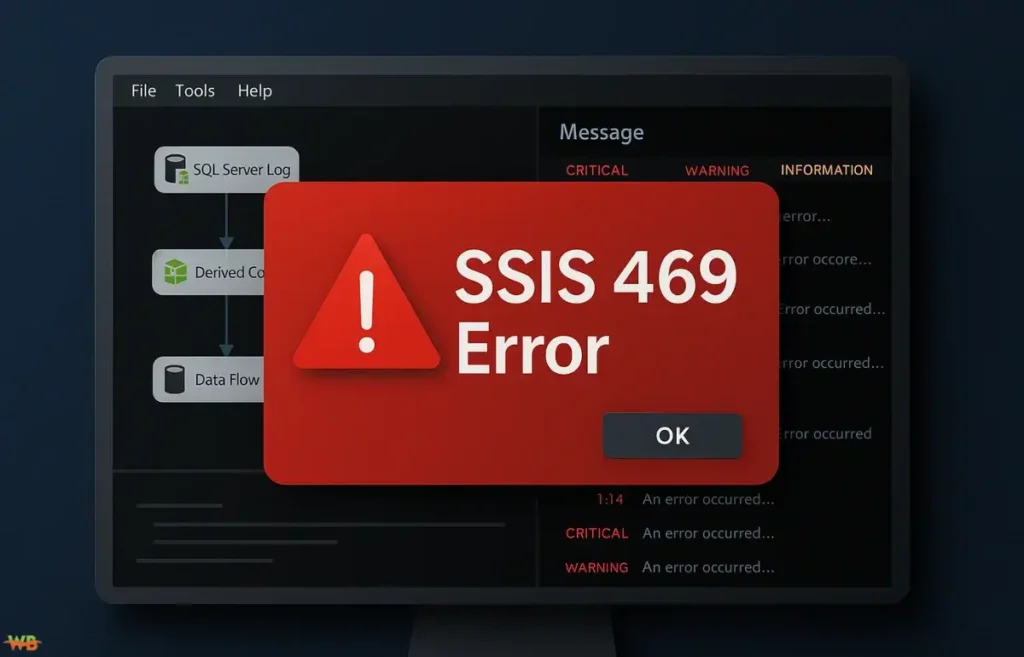If you have ever worked with SQL Server Integration Services (SSIS), you know how frustrating it can be when you run into a vague error code, especially one like SSIS 469.
This error is not officially documented by Microsoft, yet it shows up frequently in developer forums, internal logs, and troubleshooting threads. That makes it a bit of a mystery—but not one you cannot solve. In this article, we will explore what SSIS 469 likely means, what causes it, and how to fix it using a structured approach that restores the integrity and performance of your ETL processes.
Troubleshooting the Unofficial SSIS 469 Exception
Unlike standard SSIS error codes, SSIS 469 does not correspond to a known issue listed in Microsoft’s official documentation. Instead, developers have encountered this code in situations where a task or package fails without much detail.
The consensus? This is usually a generic error resulting from an underlying issue that has not been correctly caught or reported by the SSIS engine.
What makes SSIS 469 tricky?
-
It does not come with a standard error message.
-
This error can be traced back to problems within scripts, user-defined components, or data source connections.
-
It behaves like a catch-all error for issues that aren’t clearly defined.
This means you will need to investigate based on the context of where and how the error happens, rather than expecting a descriptive message to guide you.
Common Causes of SSIS 469 Errors
Let’s explore some of the most frequent triggers of SSIS 469 within a package.
Script Task Failures
A failed script task is one of the main suspects in SSIS 469. These scripts, often written in C# or VB.NET, can crash due to:
-
Unhandled exceptions
-
Invalid data types
-
Improper access to variables or external resources
Because it cannot associate the crash with a specific SSIS error number, the SSIS engine throws SSIS 469 as a placeholder.
Solution
Review the script in detail. se exception handling methods such as try-catch and set up comprehensive logs to monitor and trace issues during script execution. Use the SSIS debugger to step through your code, paying close attention to variables and data being manipulated.
Custom Component Failures
SSIS allows developers to use third-party or in-house custom components. These components can trigger SSIS 469 if they fail silently or handle exceptions poorly.
What to check
-
Compatibility with your current SSIS version
-
Logs generated by the custom component
-
Source code (if available) to inspect how errors are managed
You may need to contact the vendor or the development team if the issue is buried deep in the component’s internal logic.
Connection Manager Issues
Connection managers serve as the essential links that enable data access and transfer in SSIS workflows. If they fail due to invalid credentials, incorrect connection strings, or missing drivers, the package might fail under the vague SSIS 469 label.
Troubleshooting steps
-
Test all connections directly in SSIS.
-
Check permissions for the SSIS execution account.
-
Confirm that all necessary database drivers or OLE DB providers are installed.
-
Temporarily replace the connection with a static test connection to see if the error disappears.
Data Conversion Errors in SSIS Data Flow
A less obvious but very real cause of SSIS 469 is a failed data transformation. If you are converting string data into integers or trying to load decimal values into an incompatible column type, errors can occur.
When data conversion errors occur, the system may not indicate the precise problem and instead trigger the generic SSIS 469 error.
How to solve this
Use data viewers inside your data flow to inspect what is happening at each stage. Add Derived Column transformations to force data types where needed and capture invalid data before it causes issues downstream.
External Process Execution Failures
Invoking external programs or APIs through SSIS tasks such as Execute Process Task or Web Services Task can lead to an SSIS 469 error if those external operations fail or time out.
Action plan
-
The SSIS runtime account must have permission to interact with the targeted external system.
-
Keep a written record of execution data for diagnosing errors.
-
Run the same command manually in the command prompt to see if it produces an error outside SSIS.
Server Resource Constraints
Execution problems might stem from the system hosting the package rather than the package itself.
Insufficient memory, disk space, or CPU can cause tasks to hang or fail, with the SSIS engine defaulting to an obscure code like SSIS 469.
Tools to use
-
Windows Performance Monitor
-
Use SSIS’s native event handlers, such as OnError, OnTaskFailed, and OnWarning, to capture runtime issues
If resource issues are found, consider splitting your package or running it on a more capable environment.
How to Troubleshoot SSIS 469: A Practical Approach
When faced with SSIS 469, here’s how to structure your investigation:
1. Identify the Error’s Origin
-
Use logging to find out which task or component is failing.
-
Isolate that section and test it independently if possible.
2. Inspect Associated Messages
Even if SSIS 469 is generic, the accompanying message or log entry might be more descriptive. Pay attention to all log lines around the failure point.
3. Recheck Package Configuration
-
Revisit every Connection Manager, Data Flow Task, and Script Task.
-
Confirm data types match at every transformation and mapping point.
4. Simplify and Rebuild
Disable sections of the package stepwise to determine which element is causing the failure. Then reintroduce them one by one. This brute-force method is often effective for hard-to-trace bugs.
5. Use the SSIS Debugger
Employ SSIS breakpoints and data viewers to follow the data pipeline, monitoring transformations, variables, and record counts.
6. Log Everything
Enable detailed logs via the SSIS Event Handlers. Log events such as:
-
OnPreExecute
-
OnError
-
OnTaskFailed
-
OnPostExecute
Also, log variables into a flat file or table so you can review them during the failure.
Why Fixing SSIS 469 Matters
Leaving a generic error like SSIS 469 unresolved introduces risk into your ETL pipeline. You may be:
-
Losing data silently
-
Missing critical transformation errors
-
Compromising the reliability of your analytics
When your SSIS package is stable and clearly configured, it helps safeguard data accuracy, align with compliance needs, and sustain operational flow.
Final Thoughts: Own the Debugging Process
You may never find a Microsoft support article explaining SSIS 469, but that does not mean you are stuck. With a little detective work, smart logging, and structured debugging, you can get to the root cause.
If you consistently deal with custom scripts, complex transformations, or external services in your packages, consider building custom error-handling frameworks inside your SSIS projects. Also, keep your components and drivers up-to-date and well-documented to avoid ambiguous issues in the future.
Stay in Control of Your SSIS Environment
Dealing with issues like SSIS 469 requires more than just reactive troubleshooting—it requires proactive package design, clear logging mechanisms, and a solid understanding of your infrastructure.
When your team is equipped to handle these types of errors confidently, your entire data pipeline becomes more resilient, and that is worth the effort.
Learn about Geekzilla.tech Honor Magic 5 Pro

Ton Roobprom is an experienced writer focused on practical advice across technology, business, travel, beauty, lifestyle, and home improvements. He specializes in distilling complex subjects into clear, actionable insights to help you enhance your daily life.


